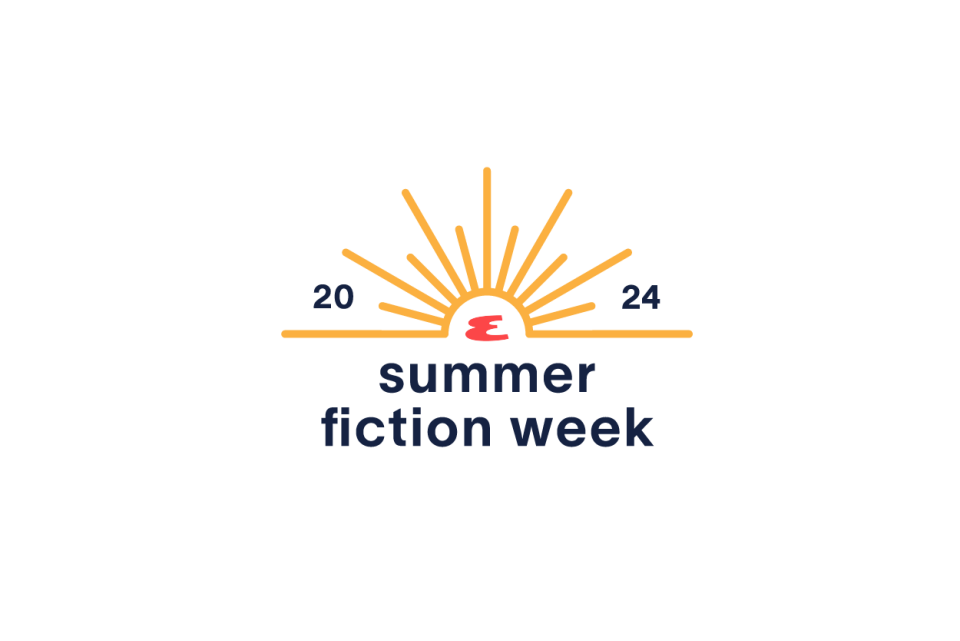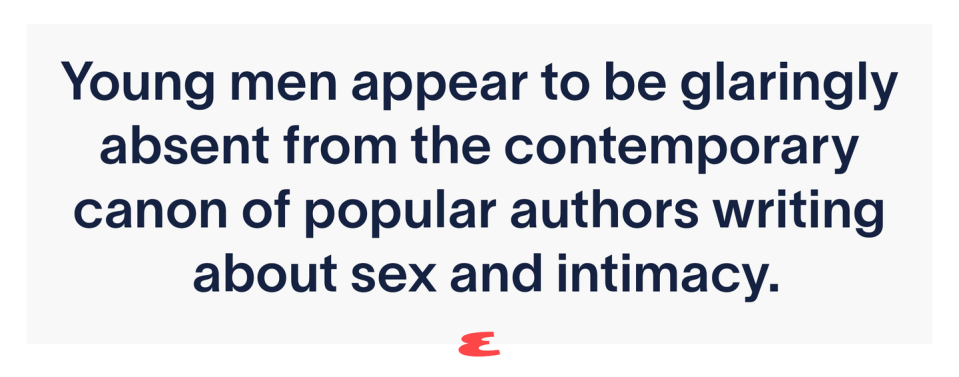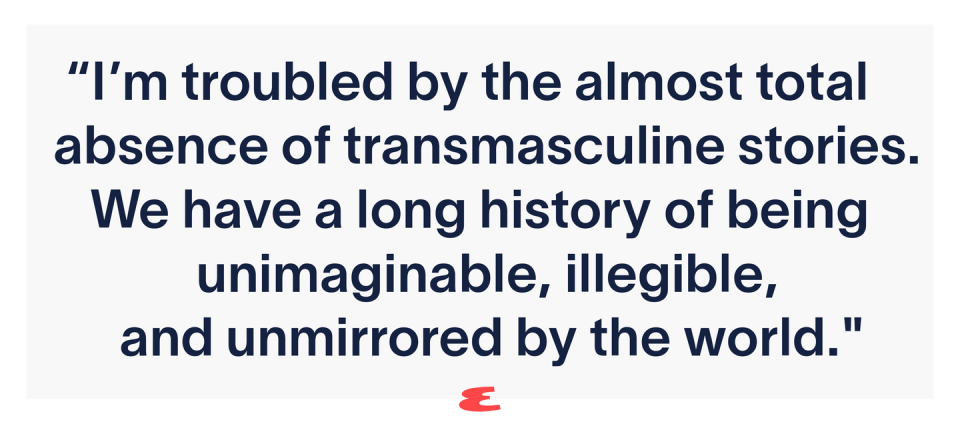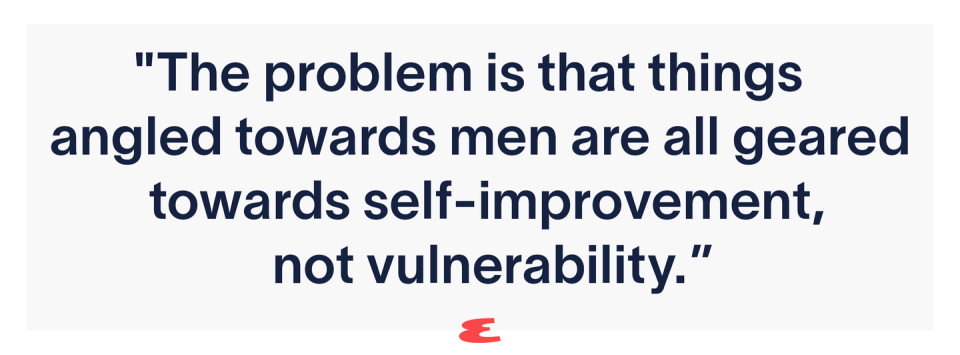Where Is All the Sad Boy Literature?


Lately, it seems like literary fiction has been unable to escape the scourge of “sad girl literature.” Though the genre has deep roots, it garnered widespread popularity during the pandemic, when it came to encapsulate the malaise of millennial and Gen Z existence: unfulfilled desires, life under late-stage capitalism, the threat of climate change, and so on. So prolific is the genre that it now seems to have flattened the branding of contemporary women’s fiction into something of a monolith. This isn’t to say that these novels are without merit—far from it!—but the way they’ve been marketed speaks of an industry stunted by the popularity of its own creation.
Where are all the sad young men in literature, then? The male equivalent of My Year of Rest and Relaxation’s droll narrator? The modern-day Holden Caulfields? As far as the Internet is largely concerned, there aren’t any. Or at least very few of them receive the same hype as books by and about women. Perhaps it’s because there’s a certain stigma surrounding male vulnerability, but in contemporary fiction, the subject is wildly overlooked. This discrepancy isn’t just a matter of representation, though: It’s reflective of wider attitudes toward masculinity. If social norms dictate that men should embody strength and stoicism, there’s little space left for those who don’t. Ultimately, fiction plays a crucial role in shaping our self-image and reality; it’s why the relative absence of young men in recent fiction profoundly affects how we perceive and understand the emotional lives of men more broadly.
Normal People’s Connell Waldron is perhaps the rare exception. In the four years since Hulu’s TV adaptation first aired, TikTok edits of Paul Mescal—spliced with excerpts from Sally Rooney’s novel—are still as popular as ever, no doubt aided by the meteoric rise of his acting career. And though Connell may not be as acerbically self-aware as Frances from Conversations with Friends or Alice from Beautiful World, Where Are You?, he arguably stands as the most captivating of Rooney’s protagonists. We see him struggle to communicate how he feels, but not for a lack of feeling or ability to articulate himself. His emotional reticence is instead a product of Ireland’s masculinity crisis, Rooney told Esquire UK, caught as he is between seeking the approval of his friends and wanting to be a good person. Through Connell, readers experience Rooney’s most lucid and moving writing—it’s little surprise, then, that she felt compelled to return to male protagonists in her upcoming novel, Intermezzo.

But even though Connell offers a strong example of a (sometimes) sad young man in literature, Rooney is a female writer. It’s not necessarily that writers should restrict themselves to writing perspectives that resemble their own (if this were the case, fiction would be in a dire state right now), it’s that Rooney demonstrates another problem with the landscape of modern fiction: Young men appear to be glaringly absent from the contemporary canon of popular authors writing about sex and intimacy.
For the past couple years, other writers have asked why this might be the case. Novelist and journalist Imogen Knights-West flagged the lack of straight men writing personal pieces about relationships last year, pointing to the “hostile reception” that this kind of work would likely receive. For women, historically the “underdogs” when it comes to heterosexual dating, she suggests that there is a unique catharsis in reading and writing about other women’s romantic tragedies. Not long before that, book critic Barry Pierce asked where all the young male writers had gone. “The fact there is no major UK or Irish male novelist, no household name, aged between twenty-five and thirty-five at the moment is immensely strange,” he wrote. Ocean Vuong, now thirty-five, might be the closest the U.S. has to this right now—though he’s arguably better known as a poet than as a novelist.
Could that be about to change? Dredheza Maloku, an editor for Daunt Books Publishing, says that she’s been “receiving exciting work by young male authors on submission, more often than not with a coming-of-age slant.” However, she can also see how the market looks like it’s saturated with female voices. “I do think we’re slowly but surely coming out of the influx of these books triggered by the success of Sally Rooney,” Maloku says.
The proliferation of queer fiction in recent years owes much to the lasting impact of André Aciman’s 2007 novel, Call Me by Your Name. This seminal work remains one of the most beloved queer bildungsromans, chronicling the tender and tumultuous romance between seventeen-year-old Elio Perlman and twenty-four-year-old Oliver, a visiting doctoral student enlisted to assist Elio’s father with various academic tasks. Critics disagree as to whether Aciman’s novel should be considered a bildungsroman or a queer romance. Either way, its lyrical prose and close grasp of the narrator’s psyche make for a gratifyingly intimate read. As Elio recounts a halcyon summer in 1980s Northern Italy, we see the young men sunbathing, swimming, cycling, and getting into heated intellectual debates. Despite the idyllic setting, there’s an underlying sadness to Elio’s narration, as he knows that his time with Oliver is fleeting—we see him counting down the “six weeks and one day” until Oliver leaves. Above all, Call Me by Your Name is a novel about desire unfulfilled, and it’s in those tender gestures, moving between the sexually implicit and explicit, that the eroticism between Oliver and Elio feels most palpable. Aciman captures the fraught desires of adolescence with an acute specificity: that need to want and be wanted, to long and to lose.
In the seventeen years since Call Me by Your Name’s release, the subject of the age gap between Oliver and Elio has dominated discourse around the book. Accusations of exploitation are rife, as is a general refusal of the idea that their relationship can be classified as a romance under these terms. But at no point did Aciman advocate for his novel to be an instructional love story, and it’s exactly this ethical murkiness that makes Call Me by Your Name so interesting in the first place.
Writing along similar lines, Adam Mars-Jones chronicles the romance between bikers Ray and Colin, beginning on Colin’s eighteenth birthday, in Box Hill. Winner of the 2019 Fitzcarraldo Editions Novel Prize, Mars-Jones flexes his literary prowess in a story that’s tightly controlled, even with a meandering, chatty narrator. Like Aciman, he makes the case for the complexities of early love. Abuse, intimacy, degradation, and tenderness coexist in a relationship spanning 128 pages and twenty-five years, with Colin insisting throughout that “Ray was good to me—he was.”

Although Call Me by Your Name and Box Hill explore the intersections of age, power, and same-sex desire between men, neither falls into morally didactic territory. Similarly, in Brandon Taylor’s novels, the writer resists crafting superficially “good” characters to suggest they are worthy of being treated well. His most recent book, The Late Americans, sees a rotating cast of grad students coupling up, cheating, fighting, and getting back together. It’s a smorgasbord of horrible people, but Taylor’s sardonic wit prevents things from getting too bleak. (“Ekphrasis is so dead, man,” says poet Seamus after getting kicked out of class for mocking the work of his peers, all of whom are women.) On the other end of the spectrum, Douglas Stuart’s Young Mungo shows how centuries of sectarian violence play out in a love story between two young men. The poverty, parental neglect, and abuse make for a harrowing read, one certainly much darker than any of the other novels.
There’s no lack whatsoever of novels by cis queer men. But where stories of transmasculinity are concerned, there is a stark shortage. Most of the texts I came across, like Paul B. Preciado’s Can the Monster Speak? and Jack Halberstam’s Female Masculinity, approached the subject through autotheory, blending memoir and critical theory, and other modes of nonfiction. In this sense, Griffin Hansbury’s Some Strange Music Draws Me In stands out as an exception, telling the story of Max (formerly Mel) looking back on his adolescence. Over the course of the novel, Max comes to terms with his experience of having lived as a girl while failing to live up to societal expectations of normative femininity. When I spoke to Hansbury about men and masculinity in publishing, he told me, “I’m troubled by the almost total absence of transmasculine stories. We have a long history of being unimaginable, illegible, and unmirrored by the world. People like me are still largely unwritten and unpublished, with a few notable exceptions.”
As for today’s male writers, Hansbury says, “If young male writers want to tell a different story about masculinity, one that grapples with interiority and all the horrors and wonders of living in a vulnerable, penetrable human body in society, then yes, there is a cultural necessity for that kind of story. It’s going to be a sad story, because to be human is to suffer, and then, hopefully, to make meaning from that suffering. As writers, we ideally offer that meaning to others, to help them make their way in a world that is often difficult to bear.”
So seems to be the case with most of the queer literature I’ve surveyed so far, but what about the sad young straight men? In an industry they’ve long dominated, do we really need more books about them? As a young woman, I’d say so. The epidemic of male suicide speaks volumes of a culture that frames masculinity as unyielding and immune to vulnerability. Fiction can offer a useful lens into that headspace, as an avenue by which we understand the lived experiences of others.
I’m not alone in my hunger to read more of these perspectives. “As a woman, I’m finding myself keen to read more novels from a young male perspective, especially if they’re exploring stories of diaspora or touching on vulnerabilities in new and exciting ways,” Maloku says. “There’s an appetite for these stories for sure, and the question now is about finding those voices. In a world that feels progressively more fractured and uncertain, are more young men turning to fiction to meet themselves on the page? Is this, in turn, fueling this appetite for more young-men-coming-of-age stories? Like any literature, the cultural value is to generate empathy and to create a space of understanding between reader and writer.”
When I spoke to various editors and writers, the topic of vulnerability cropped up again and again. While women are given credence to tell their stories and write about their pain, men are rarely offered the same outlet. It makes sense why there are fewer John Updikes and Charles Bukowskis around today, given that the literary world was so long dominated by men of that ilk—but if not through fiction, where else can men feel seen and understood?
Many have pointed to “the manosphere” as one of the main places where this might happen. Through the veil of anonymity, sites like 4chan give men a place to talk about their feelings at a time when traditional notions of masculinity feel threatened. Consisting of online platforms propagating misogynistic and anti-feminist thinking, the manosphere is also widely credited for bolstering the popularity of incel ideology, Andrew Tate, and, of course, Donald Trump.

Ben Lerner’s 2019 novel, The Topeka School, seeks to make sense of this masculinity crisis across generations. Returning to his autofiction alter ego, Adam Gordon, Lerner delves into the complexities of modern masculinity against the backdrop of 1996 Kansas, where he draws striking parallels to the cultural aftermath of Trump’s presidential tenure. While the interrogation of language—its possibilities and its shortcomings—is nothing new for Lerner, it’s the first time his fiction shows its potential as a serious weapon. Adam tells us that he dreams of becoming a poet “because poems were spells, were shaped sound unmaking and remaking sense that inflicted and repelled violence and made you renowned.” Meanwhile, Adam’s classmate Darren Eberhard is radicalized; he transforms from a sympathetic and isolated figure into an archetype of reactionary white masculinity, as well as a gun-toting member of the Westboro Baptist Church. As an adult, Adam encounters Darren wearing a MAGA hat. He observes that Darren is “heavier than the last time [he] saw him, bearded, almost certainly armed.”
If The Topeka School makes anything evident, it’s the close relationship between radicalization, masculinity, and political rhetoric. At times, Lerner even suggests that language itself has been exhausted of possibility: “This language has reached its limit,” Adam’s mother says. “A new one will be built. Sima and I will build it.” As a competitive debater, Adam closely observes his opponents, employing a technique called “the spread,” in which arguments are presented in such quick succession that they’re almost impossible to respond to. “It’s not that the audience really learns anything about these people or events,” he explains. “It’s about how naturally these foreign signifiers roll off the teenager’s tongue.”
It might be tempting to read The Topeka School as foreboding of a nightmarish future, but woven into this story of psychoanalysis and radicalization is also the promise of something better. Rather than abandon hope, Lerner encourages us to turn to those smaller, incremental acts of speech that bring us together. Moments like these abound throughout the novel, from Adam’s musings on the wonder of poetry to his present-day self singing at an ICE protest with his wife and daughters. Lerner shows us not only the power of language for good but also the novel’s power as a tool of empathy.
Lerner, however, is no longer a young man. Aciman, Mars-Jones, and Stuart aren’t, either. But in my search for young male novelists writing coming-of-age stories, the names of two writers came up again and again: Michael Magee and Caleb Azumah Nelson.
In Close to Home, Belfast native Magee delivers a profoundly humane narrative that confronts the systemic challenges of class and belonging in a society marked by economic collapse and the lingering effects of Ireland’s Troubles. In a stark tonal contrast, Azumah Nelson’s debut novel, Open Water, intricately weaves a love story between a photographer and a dancer against a backdrop of Black exuberance and artistic expression, exploring their challenges and emotional intensity. These books tackle the fissures of the UK’s uneasy sociocultural history in very different ways, but where craft is concerned, Magee and Azumah Nelson both excel.
Like Open Water, Bryan Washington’s Memorial forensically examines the aftermath of colonial violence in everyday life. Set in Houston’s Third Ward, the novel depicts the fractured relationship between Benson, a middle-class Black man, and Mike, a Japanese American chef. Both men are caught between the past, present, and future, fundamentally unable to escape the systemic forces—race, class, sexuality—that shape who they are. Washington handles his subjects with serious care and empathy, recognizing that it’s only by shifting viewpoints and briefly relinquishing our own that we can see the world from a new perspective. Here, Magee, Azumah Nelson, and Washington feel like premonitions of an exciting new wave of young male writers. It’s for this very reason that we need more of them: because what we read can change the way we see ourselves, other people, and the world around us.

But that idea doesn’t always result in positive perceptions. Consider male readers of David Foster Wallace, Haruki Murakami, and, to a lesser degree, Thomas Pynchon. By no fault of their own, these writers have earned reputations as the apex of white male pretension; today, their books have acquired cult status as signifiers of misogyny. This seems to be especially true of Wallace’s Infinite Jest, a book so notorious that even those who haven’t read it still feel entitled to make snap judgments about the kinds of men who have.
It’s easy to argue that this kind of thinking is a product of performative reading on social media. Although the gargantuan popularity of #BookTok might suggest that literary consumerism and its co-option as a tool of personal branding is a new phenomenon, the relationship between reading and identity has been around for centuries. Literary historian Stephen Greenblatt proposes that masculine “self-fashioning” via fiction reading was so abundant in the early modern period that society deemed it fundamental to the construction of an ideal masculinity and public persona. As fiction became more intertwined with its social, political, and cultural context, selfhood increasingly emerged as a product of literature, forging a reciprocal relationship between the two.
If not through fiction, what other kinds of media consumption are young men using to fashion themselves today? Jamie Cameron, managing editor of literary and arts periodical The London Magazine, offers a theory: “Publishing has typically been dominated by cis, straight, white men who used to publish those sorts of coming-of-age stories all the time,” he says. “It was an oversaturated market for sure, but now the problem is that things angled toward men are all geared toward self-improvement, not vulnerability.”
Cameron goes on to say: “That’s supposedly the whole appeal of figures like Andrew Tate, as they constantly put the onus back on being more masculine and making more money, and what it is that you, as a man, are failing to do. Most of the literature I see marketed toward men these days isn’t fiction, but it’s books along those lines. Instead, it’s all books by Jordan Peterson, Steven Bartlett, and Elon Musk. That’s where the big problem is, I think, in that there’s no mainstream literary framework for masculinity to exist outside of this brand of aggressive neoliberalism. If that’s not what young men aspire to, what is the alternative?”
Cameron raises a compelling question. This also shows why coming-of-age novels written by and about young men have only become more necessary throughout the years. As for the question of whether there’s space for them, Maloku insists there is. “If there is an appetite for these books, then the publishing industry will seek them out and publish them,” she says. “The real question is, are men being more vulnerable than they used to be, or are we just more interested in these stories now because readers are bored of the same stories written by the same kinds of people?”
Whatever the answer may be, there’s clearly an appetite for more diverse narratives in literary fiction. Indeed, the books I’ve discussed show promise of an industry evolving into something entirely new. Gone are the days when only certain voices were front and center; now the new canon of male writers includes voices that are queer, Black, trans, and beyond. As I consider what literary masculinity might mean today, I’m struck by something Hansbury said to me: “If masculinity is threatened, hopefully it’s the old masculinity of extraction, violence, and domination.” I couldn’t agree more.
Prop styling by Miako Katoh
You Might Also Like


